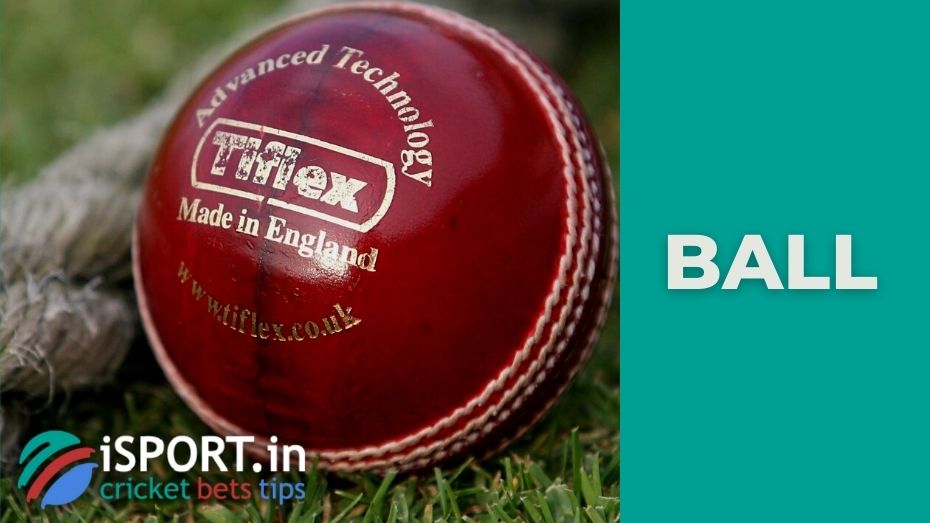Ball

In all ball sports, teams score points when the ball reaches a designated zone. The ball in cricket is initially in the possession of the bowling (attacking) side. The sport uses a relatively heavy and hard ball, which means injuries are not uncommon.
Ball in cricket: Two Meanings
The word ball in cricket has two meanings. First, it refers to the actual object used in play. The bowler delivers it, and the batsman attempts to strike it. This round ball is covered with leather and stitched with several seams, allowing it to move unpredictably in the air.
The second meaning of ball refers to a single delivery. An over in cricket consists of six such deliveries.
Ball in cricket: What Is It Made Of?
For the ball to be used in official cricket matches, it must be certified according to British Standard BS 5993. The classification specifies the requirements for the size, quality and other characteristics of the ball. A ball in cricket is made of cork. The second layer is a tightly wound thread, and then everything is “packed” in a leather case.
It is also important to note that there must be a seam when making the ball. To understand how the leather covers the ball, experts suggest imagining an orange, the coating of which is divided into four parts. At the same time, one hemisphere is rotated by 90 degrees with respect to the other. In the middle, the cricket ball is sewn with a string with six stitches. Two more seams pass from inside the ball, and this allows you to form a quarter seam.
Training balls are made using a simpler process. For safety reasons, beginners and children typically don’t use standard cricket balls. Instead, they often play with tennis balls, which are partially wrapped in tape to mimic the appearance and feel of a real cricket ball.
Ball in cricket: How Is It Used in the Game?
The player must have a certain skill and know how the ball behaves in flight to show good results. This is influenced by both the movement of the hands during the swing and the accentuated work in the final part of the throw. It is important to note that cricket balls are heavier than baseball balls. There are three types of the ball in cricket:
- Red Ball: The traditional cricket ball, used in Test matches that can last several days.
- White Ball: Used in limited-overs formats, often preferred for night matches due to its visibility under floodlights.
- Pink Ball: Introduced in 2010, designed for day-night Test matches. It stands out clearly against players’ white uniforms.
In contrast to other sports:
- In football, multiple balls of the same type are used and rarely fail.
- In tennis, balls are changed after the first seven games and then every nine games.
- In cricket, balls are replaced only at specific times depending on the match format and condition of the ball.
In Test matches, a new ball is introduced at the start of each innings. In limited-overs formats, two balls are used — one from each end. Umpires may also authorize a replacement if the ball is lost or significantly damaged. After 80 overs in a Test match, the bowling side’s captain may request a new ball.
If a ball ends up in the stands, spectators are expected to return it. If the ball is stolen or cannot be retrieved, the umpire must provide a ball of similar condition and type.
Because a single ball in cricket is used for extended periods, it gradually wears down. To compensate, bowlers employ tactics like polishing one side of the ball on their clothing — hence the frequent stains on players’ trousers. Only one side is polished, allowing bowlers to generate “swing” through the air. Additionally, an older ball can be used to create reverse swing or spin after it bounces.
To avoid constant manipulation from cricketers, special bans were created for certain actions:
- Players are not allowed to rub the ball on the ground.
- Cricketers cannot rub any liquids into it, except sweat.
- It is forbidden to lift the ball’s seam in any way and deliberately cling to it with nails or sharp objects.
- With the beginning of the coronavirus pandemic, players were forbidden to smear the ball with saliva. In case of violation of this paragraph of the International Cricket Council rule, a team may be issued up to two warnings during an innings to start. In the case of the third attempt of manipulation, a 5-run penalty to the batting side is imposed.
If the ball in cricket is out of play for some reason, then fast bowlers like to play the new ball. They take advantage of the greater unpredictability of the rebound from the field. At the same time, old balls are more suitable for spin bowlers.
Ball in cricket: Dimensions
Ball specifications may vary slightly by manufacturer. The most well-known brand is Kookaburra, headquartered in Melbourne, Australia. Kookaburra white balls are standard for Twenty20 (T20) matches, and their red balls are widely used in Test matches — except in three countries:
- India uses Sanspareils Greenlands (SG) balls, made locally.
- England and the West Indies use Dukes, a British manufacturer.
The following characteristics must be observed by the organizers of the competition when providing balls, depending on the age of the participants:
| Cricket ball specifications | Weight | Circumference |
| Men and boys 13+ | 5.5–5.75 oz (156–163 g) | 8.81–9 in (224–229 mm) |
| Women and girls 13+ | 4.94–5.31 oz (140–151 g) | 8.25–8.88 in (210–226 mm) |
| Children under 13 | 4.69–5.06 oz (133–143 g) | 8.06–8.69 in (205–221 mm) |
| Younger children | A plastic ball such as a «Kwik cricket ball» is often used | |
Ball in cricket: Danger
A ball in cricket can reach a speed of 160 km/h during flight. Due to its weight and hardness, players must stay constantly alert. That’s why more batsmen, including traditionally helmet-averse Australians, now wear protective gear.
The first information about the victims of the cricket ball appeared in the 18th century. According to unofficial information, in 1751, Prince Frederick of Wales was injured shortly before his death just in a cricket match. Unfortunately, later there were several more unpleasant cases, a large number of which belong to the 21st century:
- 1971: Roger Davis (West Indies) suffered a serious concussion but later returned to play.
- 1998: Indian player Raman Lamba died after being struck in the head during a club match while fielding without a helmet.
- 2009: Umpire Alcwyn Jenkins died after being struck by a ball.
- 2013: South African cricketer Phillip Hughes died in hospital after being hit during a match.
- 2015: A tragic month saw the deaths of both Hughes and Hillel Oscar (former captain of the Israeli national team and then an umpire), each struck fatally by a ball.
- 2017: Pakistani player Zubair Ahmed died from a similar incident.
Experts draw attention to the fact that coaches working with children need to constantly remind their wards about the danger of a cricket ball.
